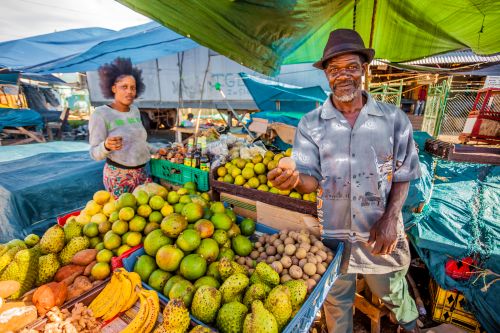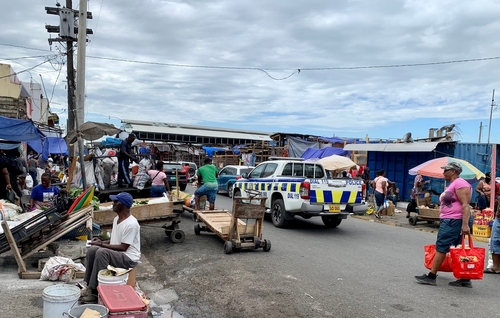Market Memories: Discovering Kingston’s Curnashan Mawkit

by Dr. Leo Gilling

Coronation Market Higgler
During the lively and transformative years of the 1960s and 1970s, she emerged as a trailblazing Northeastern higgler—though at that time, the very term was hardly recognized. A higgler is an itinerant trader, meaning they travel from place to place to sell their goods. My mom was not only a pioneer, but she was also highly respected and successful in her chosen entrepreneurship. Her stops included Boscobel, Stewart Town, Three Hills, Charles Town, Ocho Rios, and several other districts across St. Mary and St. Ann.
Armed with her trusted “dulcimina suitcase,” she navigated the vibrant market scene with tenacity and grace, cultivating a thriving business that blossomed before me. Her tireless efforts enabled her to purchase three vehicles within an impressive span of eight years and eventually secure a spacious six-bedroom home, a testament to her entrepreneurial spirit, by the late 1970s.
While the setting has shifted, I find a striking similarity between her journey and the dynamic vendors at Curnashan Mawkit, who hustle daily under the colorful awnings of the market structure. Each stall, brimming with fresh produce, spices, and handmade goods, echoes the same determination and ingenuity that characterized my mother’s own quest to create a better life. Their shared resilience and resourcefulness paint a vivid picture of the unyielding spirit that defines the marketplace and the people who thrive within it.
Familiarity with Kingston
This personal narrative is not just a meandering account; it highlights my familiarity with Kingston and illustrates the transformative power that local commerce wields over the lives of individuals and families. Growing up, I vividly recall the many times I accompanied my mother on our expeditions to downtown Kingston, specifically King Street, the buzzing shopping area.
We would depart Oracabessa on public transportation like Victor and Mailbus services and Mr. Piggy Transit minibuses and navigate the bustling streets by walking, moving from store to store seeking the best products for resale for our dollar spent. Shopping ended at about 4 p.m. as we walked to West Street, where we would patiently await the ride back to the tranquil landscapes of St. Mary.
I once believed that I had explored the vibrant streets of Curnashan Mawkit during a previous shopping trip, but upon my recent visit, I was struck by the realization that I had never set foot in this bustling marketplace. The atmosphere felt unfamiliar, almost like a scene pulled from a different time. The lively buzz that enveloped the marketplace last week mirrored the energy it must have had fifty years before.
Market’s Rich History
This epiphany sparked a curiosity within me about the market’s rich history; it became clear that I had never truly experienced the essence of Curnashan Mawkit before. As my friends and I arrived there last week, I found myself grappling with a wave of mental challenges, largely fueled by anxiety.
My mind flooded with unsettling tales of gang violence and impending danger. I couldn’t shake the fear of being forcibly yanked from my car at gunpoint. As we moved through the area, I kept my windows shut and my doors locked. I wanted to protect myself from the chaos outside. A persistent sense of unease gripped me, amplified by the heavy traffic flow surrounding the market.
The single-lane roads, cluttered with vendors, shoppers, and many vehicles, only heightened my frustration. Other times, while I drove through this area, attempting to rush to the airport, I found myself ensnared in a gridlock that felt inescapable. My anxiety intertwined with the worry of what might unfold around me. I was constantly preoccupied with thoughts of missing my flight, trapped in a whirlwind of uncertainty and tension.
Despite my previous apprehensions, Thursday’s visit unfolded as a remarkable opportunity for growth and discovery. Accompanied by a knowledgeable friend who regularly navigated the bustling market every other week, I felt a wave of relief wash over me, gradually easing the knots of worry that had tugged at my chest. For once, I wasn’t sweating profusely, trapped in a frigid choke of fear, or frantically searching for an exit from this vibrant venue.
As we approached our destination, the driver pointed out the parking area nestled within the Tivoli neighborhood. “Tivoli?” I questioned, a hint of confusion lacing my voice. “What are we doing in Tivoli?” Yet, almost instinctively, I began to calm, shedding my concerns about the safety of his vehicle. He appeared unfazed, exuding confidence as he reassured me that after managing the bustling throng of “parking attendants,” we were safer than if we were enclosed in a steel-enforced prison. “The area is relatively crime-free,” he declared with an assured smile. Though those words seemed almost too good to be true, they wrapped around my anxieties like a soothing balm, quieting the storm within.
As we made our way, the driver captivated me with a rich historical narrative of the Coronation Market, weaving tales that traced its origins from the harrowing days of slavery to the pivotal moment of emancipation. His vivid storytelling not only quelled the remnants of my fears but also ignited a fervent academic curiosity within me about the socio-historical dynamics that underpinned the market. The stories painted a vivid picture of resilience and transformation, intertwining the past with the present in a way that made me eager to explore further.
Beneath the surface of Coronation Market lies a profound history, a silent testament to the heartache of enslaved individuals who suffered immensely during the transatlantic trade (Anderson, 2001). This layer of sorrow seems to whisper through the very soil, connecting the present to a painful past. However, during my two-hour visit, I was struck by the absence of visible reminders of such tragedy. Instead, I was enveloped in a vibrant tapestry of life that thrummed with energy and resilience.
Kaleidoscope of Jamaican Goods

I was drawn to the earthy herbs, their vibrant greens promising fresh flavors, and hearty yams stacked like golden treasures, each a testament to the land’s richness. Sun-kissed coconuts beckoned with their promise of refreshing quench, while clusters of sweet bananas added a pop of cheerful yellow to the scene.
All around me, the market buzzed with life. People were busy talking and trading. This energy supported a lively local economy. In this vivid atmosphere, the spirit of resilience flourished, beautifully juxtaposed against the weight of its hidden history.
The atmosphere crackled with the spirited sounds of bartering, laughter, and friendly exchanges between buyers and sellers, presenting a stark contrast to the somber history often associated with the place. As I wandered through the lively stalls, a vendor’s voice rang out, “One pound five shillings fi pine!” Curiosity piqued, I approached her, “What does that mean? I asked. Only to be met with a playful shrug. “I don’t know, ask my dad,” she said, gesturing to her father beside her, who wore a broad, knowing grin.
Savoring Local Delicacies
As I savored the local delicacies—sweet bananas that melted in my mouth and refreshing jelly coconuts that quenched my thirst I observed my friends eagerly stuffing their bags with groceries, the sheer volume of which numbered around ten bags. This scene beautifully underscored the market’s role as a vibrant hub of cultural and culinary exchange. Every Wednesday, I noticed trucks coming in from the countryside. They were full of bright fruits and vegetables. The farmers’ smiling faces made me happy. They were heading to Coronation Market after a busy weekend.
As I made my way around Curnashan Market, a profound change washed over me, reshaping my understanding and perception of this lively community. The vibrant colors, enticing aromas, and dynamic energy of the market confronted my previous notions, fostering a deep appreciation for the strength and spirit of Jamaica’s community markets. The sheer expanse of the market, bustling with a vibrant tapestry of sellers hawking their wares and shoppers eagerly navigating the crowded aisles, presented a scene I had rarely encountered elsewhere on the island.
Coronation Market: A Cultural Gem
I look forward to future visits. Especially, to share these experiences with my friends from the diaspora. I know they will enjoy them as much as I did.
As I conclude this article, I’m inspired by how my recent visit to Coronation Market reflects the themes of my forthcoming book, “From Shadows to Sunshine: The Story of My Childhood.” This vibrant journey through bustling stalls and rich histories revived cherished memories and enhanced my appreciation for resilience and community spirit, core elements of my narrative. I invite you to join me on this meaningful exploration in the pages of my book. Kotch and wait. It soon come!

Diaspora Strategist & Engagement Advocate
Chairman
Jamaica Diaspora Taskforce Action Network
(JDTAN)





